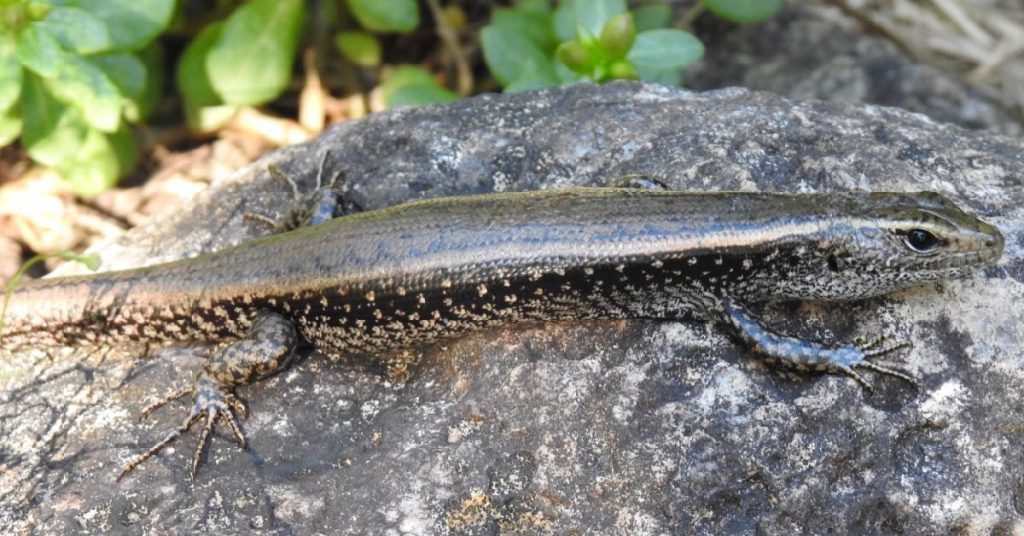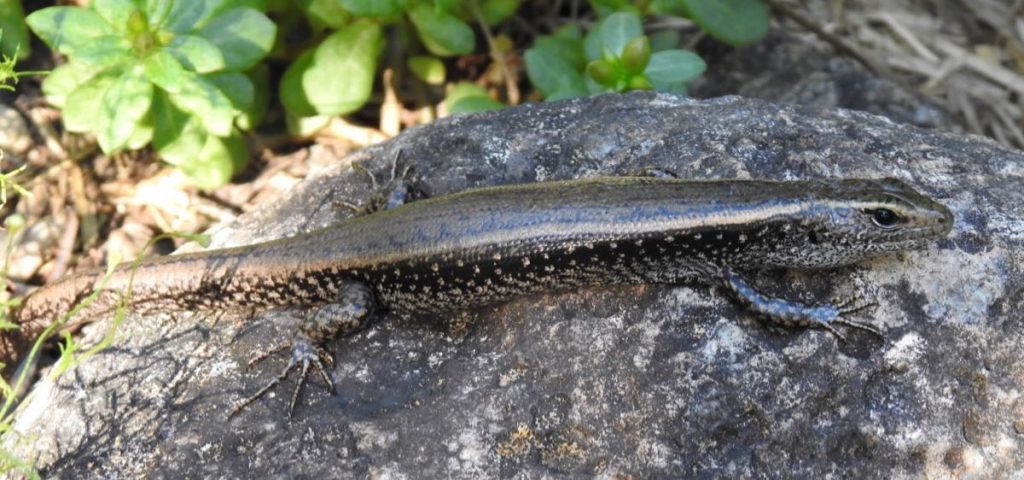The Eastern Water Skink (Eulamprus quoyii) is a relatively large skink, growing up to 30cm in length. These skinks are common at Paluma and are often observed in gardens and on walking tracks, mostly basking in the sun. I have skinks living in and around my garden, in the garage and on the roof of the house. Mostly I see them when I am gardening and especially when I am disturbing the mulch or leaf litter. They wait nearby, closely watching the ground for any movement of insects for them to eat. Their diet consists of small invertebrates including worms, snails, insects and spiders and smaller lizards. They have also been recorded eating ripe fruits and berries.
As their name suggests, Eastern Water Skinks love the water. They are adept swimmers and can remain submerged for some time. They tend to live close to streams, creeks and waterways, as well bushland and vegetated urban areas.
As reptiles, Eastern Water Skinks need to generate body heat by basking in the sun – they are solar-powered skinks! They also regulate their temperature by cooling off in water. I have often seen them seeking out the sprinkler on hot summer days to sit under the cooling sprays of water.
These skinks have beautiful colouration which also makes them masters of camouflage in the garden and amongst the rocks and foliage of bushland. Their upper body is dark to golden brown in colour with a coppery-olive sheen. Along their sides they are dark-brown to black in colour with whitish spots and a yellow to white stripe that runs along each side of the body from the eyes to the tail. The underside (belly) is usually pale white or grey in colour.

During the month of April, these skinks will start preparing for winter by basking in the sun for many hours and by feeding as much as possible. In winter they will brumate – this means they conserve their energy by resting much of the time and they will only leave their shelter to search for food when necessary. They do not fully hibernate, but they reduce their activity substantially compared with the warmer months of the year.
Eastern Water Skinks mate during spring and the female gives birth to live young, usually between two and nine young in each litter. The tiny baby skinks are independent from birth.
To encourage these beautiful skinks into your garden, plant some low-growing native shrubs and ground covers. Place mulch, leaf litter, rocks, logs, sticks, branches and other places for them to shelter around the garden. A water feature such as a small pond or birdbath will also encourage their visitation – with the added benefit of bringing in the birds and frogs too!

Text & Photos by Michele Bird (For Roy who inspired my interest in these skinks and who was originally going to write this article).

For many many years following purchasing my “CozyCottage” we had the original cupboards standing in one bedroom. Every weekend visit, Neal and I would find two of these skinks living in the cupboard and most affronted that we encouraged them back into the garden. The cupboard was finally removed but that did not stop the lizards. Often, we used complete school and Uni projects on the weekends. While busily working away at the dining table, I was completely surprised by a fierce nip on my big toe. Neal, rapidly refused to take responsibility, and there running away from under the table, (looking triumphant) was one of those skinks. Maybe “pay back” for removing their home within our home!!!!
What a great story Linda. I will watch my toes from now on!!!